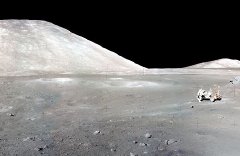Jan 9 2009
If you listen closely, you might hear a NASA project manager singing this song. Lately, Marshall Space Flight Center's Carole McLemore has been working at the end of a sledge hammer opposite a big pile of rocks, so she has good reason to sing the song Tennessee Ernie Ford made famous.

"I call it 'choppin' rocks,' " says McLemore, who manages Marshall's Regolith Simulant Team." The guys keep correcting me. 'It's 'bustin' rocks, Carole,' they say."
Whether choppin' or bustin', what's this petite woman doing with a sledge hammer in her hands? She's making fake moon dust.
"We call it "simulated lunar regolith'," says McLemore. "We need just the right kind of rocks to make this stuff, and we're getting them from the Stillwater Mine in Nye, Montana."
The Marshall team is working with the US Geological Survey (USGS) to develop a realistic moondust substitute, or simulant, in support of NASA's future lunar exploration. Team members pound on boulder sized rocks to break them into manageable chunks, dump these chunks into buckets, and lug the buckets over to pickup trucks containing reinforced containers to hold the rocks. The pickups carry the rocks down the mountain for loading onto 18 wheelers that transport tons of the material to the USGS in Denver. The USGS makes the simulant by crushing and grinding the rocks and blending in small amounts of natural minerals according to a well-researched "recipe" to approximate the make up of genuine moondust and moon dirt.
This is a lot of work, but McLemore believes it's worth the effort: "NASA plans to send humans to the moon to live and work, and the place is filled with gritty dust and powder that sticks to space suits, equipment – to anything and everything," she explains. "It's even inhaled into lungs. So we need high fidelity simulant to work with here on Earth to learn how to work in the real thing up there on the moon. There simply aren't enough Apollo samples of real moondust to do all the research that needs to be done."
Simulated regolith can be used as a "guinea pig" to help researchers find ways to make useful things from moon dirt. A favorite example is concrete. Adding, for instance, epoxy to lunar regolith makes a very strong concrete that could be used to build habitats or other structures. Properly baked, a mixture of sulphur and moondust also makes good concrete, and other recipes are sure to be found as the research progresses. On the moon and later on Mars, local resources are going to be crucial to astronauts who can't remain wholly dependent on Earth for supplies.
Working with simulated moondust may help researchers figure out how to extract valuable elements and minerals from the real thing.
"For example, moondust and many moon rocks are rich in oxygen," says Christian Schrader, a geologist on the Marshall regolith team. "If we can figure out how to extract it, humans could actually use moondust as a source of breathable air in a future lunar habitat. And the oxygen, along with the hydrogen that exists in the dirt, rocks, and possibly in polar ice, could be used to generate electricity using fuel cells, which make drinkable water as a by-product. Hydrogen and oxygen are also rocket propellant."
It seems that the Stillwater Mine has "the right stuff" to use as feedstock in creating the simulant so vital to lunar research. Some of the rocks there are 2.7 billion years old.
"There's a huge magma chamber that formed under the ground there," says Schrader. "The magma crystallized over time and formed thick layers of what we call 'anorthosite.' The geology at Stillwater is roughly analogous to how the moon's highland crust crystallized and cooled, so it's a great place for us to go rock collecting."
That's why these scientists are heading up the side of a rocky mountain with sledge hammers and pick axes to pound away at big boulders that promise to yield, albeit with great resistance, good rocks for making regolith.
"Sometimes arctic winds blow down off the mountains and pummel us while we work," says Schrader. "It can be brutal."
But it's all in the name of science. So don't just stand there leaning on your shovel! Start choppin'!